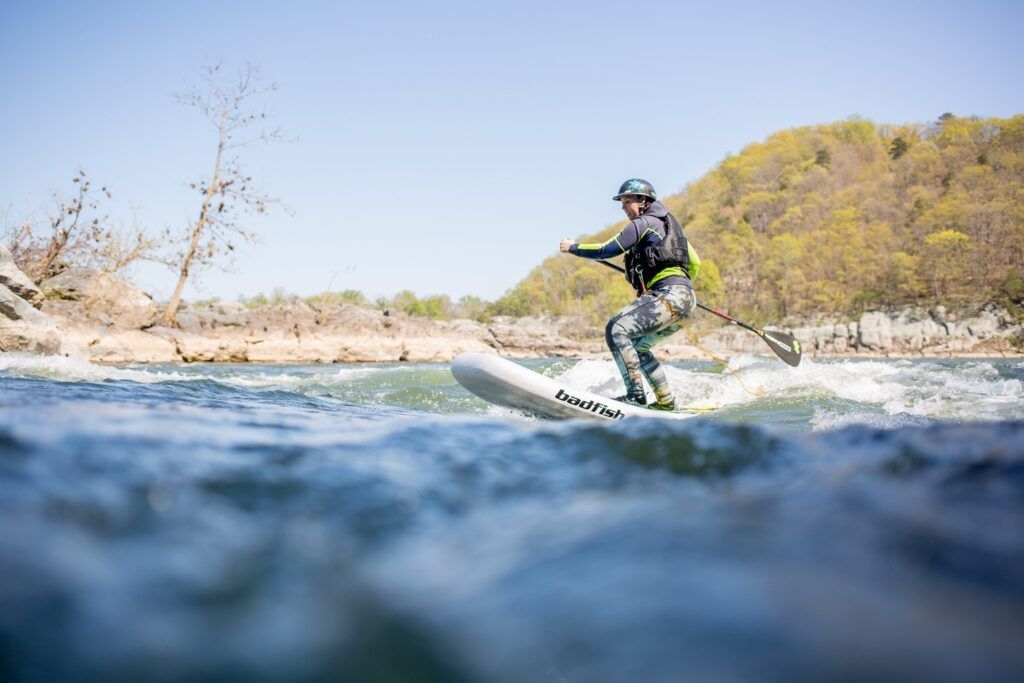SUP: How to Dress the Part
Meredith Jorss May 16th, 2016 Posted In: Articles Tags: SUP
When you think of SUP (stand up paddle boarding), do you think of sun, sand, and turquoise waters? A lot of advertisements would have you assume SUP is a fair-weather, summertime-only, or resort-specific sport, but that’s actually not true. In my hometown of DC, people SUP on the river year-round, and this means dodging ice that’s floating downstream and dressing for cold air and water temperatures.
If you’re not that hardcore, that’s okay, neither am I. My water’s frozen in the winter and you can find me snowboarding at the closest mountain. But, when that snow’s melted and I dust off my SUP by mid-Spring, I still have to be aware of cool temperatures and dynamic weather when I hit the water.
Typically, SUPers want attire that isn’t going to restrict movement. While our activity takes place out of the water on top of a board, SUPers always need to be prepared for an immersion. This means that you need to consider how you’ll feel getting back on your board with wet clothing and skin.
The main weather factors to help you determine your personal dress code are water temperatures, air temperatures, wind conditions, solar heat, and cloud cover. For example, getting wet from 60 degree water temperatures will feel different if you’re paddling on a sunny, 80 degree day or a cloudy 50 degree one. It seems pretty simple, but you’d be surprised how many people forget this, allured by those tropical vacation ads in the airport.
Layer up in moisture wicking and quick-dry articles of clothing. This can include poly base layers and rash guards. Remember the outdoor mantra, “cotton kills.” Thicker clothing like neoprene, which is the fabric used in wetsuits, can give an extra, warmer layer of protection against the elements. There are countless outer neoprene layers you can purchase, like vests, hoods, boots, and gloves.
If you’re just not sure, pack a dry bag with additional options or even duplicates. You can always swap wet clothing with dry if you’ve got it on-hand.
When it comes to more significant paddling attire you have two options: wetsuits and drysuits. There are specific times when you want one over the other, though many times it comes down to personal preference. What makes you comfortable? How much is that comfort worth to you? So, let’s review the purpose of each of these articles of clothing:
Wetsuits
Wetsuits come in different thicknesses measured in millimeters. They’re usually broken down in two numbers, for example 3/2 or 5/4. The first number indicates the millimeter thickness of the core body. The next number, which is always smaller, represents the millimeter thickness of the extremities (e.g. arms and legs). For instance, a 3/2mm fullsuit means the chest, back, and abdomen are covered in 3 millimeter neoprene, and the arms, under arms and legs are covered in 2 millimeter neoprene.
Wetsuits don’t keep you from getting wet, but rather give you warmth by heating the water between the neoprene and your body. This is part of the insulation.
Drysuits
A drysuit keeps your body dry. In most cases it will have a latex gasket at the neck and wrists to prevent water from entering. Most have built in booties to cover your feet. You can layer as much or as little as you want underneath.
You know your body better than anyone else and you’re the best person to determine which option is better for you. The bottom line is, one drysuit or one wetsuit won’t do it all. There are different types of each of these suits that will provide more or less warmth and could be useful for different conditions and types of paddling.
So, here’s what my spring paddling attire currently consists of while I’m on the river:
The water temperature has stayed fairly consistent around 60 degrees, give or take a few degrees because of weather. But, the air temperature has fluctuated a lot. Two weeks ago it was sunny and 70 degrees outside, and this is what I wore.

Even though the weather was warm, I knew there was a strong likelihood I’d be getting wet. It is the river after all, and you have to be prepared for the immersion. I wore neoprene booties, 2mm Jane wetsuit, and a rash guard over top. This provided me with some insulation should I get wet (and I did), but not enough to make me overheat.
Fast forward to another day with air temperatures in the 50s, and this is how my clothing choices changed.

I wore neoprene booties, 3mm neoprene pants, a rash guard, and a 2mm neoprene hoodie on top. After falling in, I had to be sure the air temperatures weren’t going to cool me down too much. The extra layers of neoprene helped cut the wind and provide warmth.
Ultimately, it takes time on the water and experience to help determine your personal comfort level with the many elements you’ll encounter on your SUP. The important thing is to always be prepared by checking the weather forecast, layering or bringing additional options in case the weather changes, and getting out and having fun! Now, go paddle!


Hi!
I wanted to thank you for this great and informative post!
It was very thorough in considering location and addressing cold water safety and laws!
Thank you! ❤️
Hector Alers